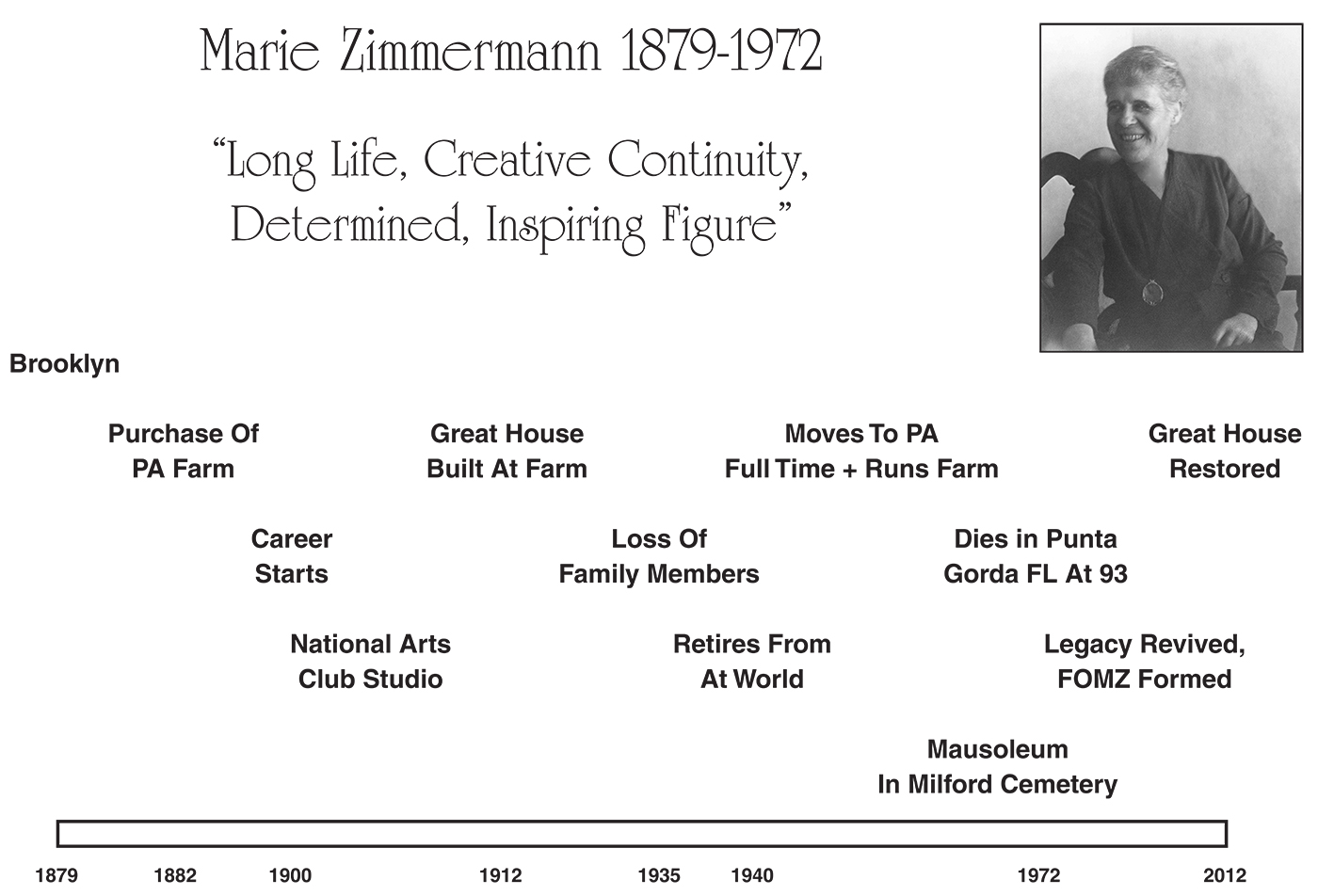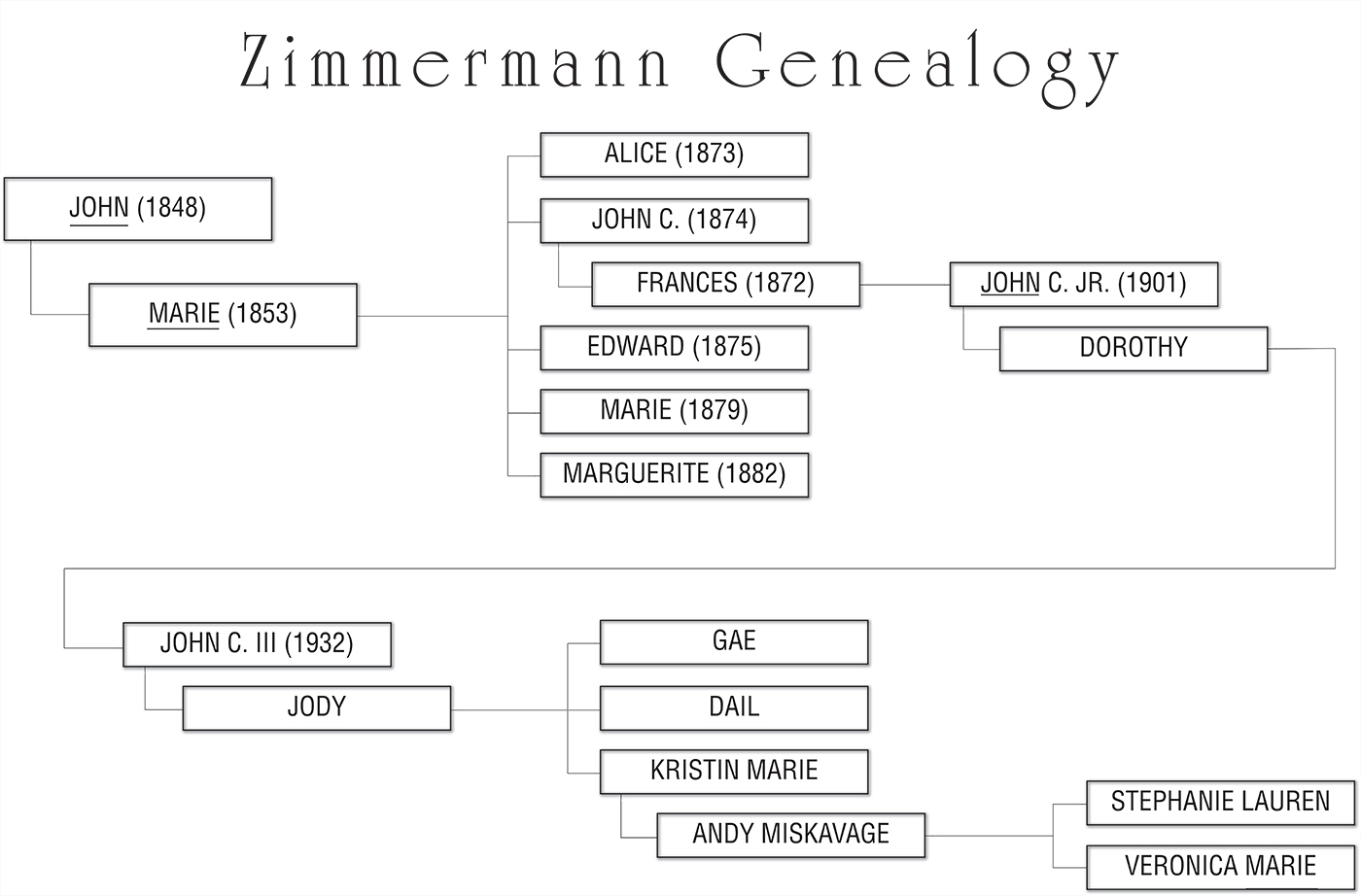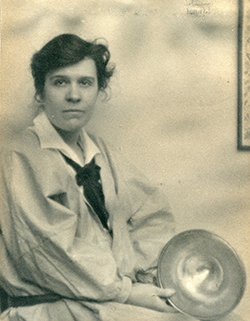
Marie Zimmermann 1879-1972
Marie Zimmermann led a long and creative and determined life, and in the end inspires us all. She was born in Brooklyn in 1879 to John and Marie Zimmermann. She was the 4th of five children.
In 1882, Marie's family purchases a farm property along the Delaware River near Dingmans Ferry, PA, as a weekend and summer second home. As she grows up there, Marie is enthralled with the natural world around her and learns to shoot and fish. This seems to spark a creative sense and she decides to become a metalsmith, after taking some courses at Pratt Institute, and after considerable debate with her father, who wants her to become a doctor.
By 1910 she has established her talent with many commissions from around the country and she takes a studio in the prestigious National Arts Club in New York.
About this time, she also lends her design sense to the building of a new family home (Dutch Colonial Revival with Breton influences) at the farm, which faces a wide curve in the Delaware. It is a slate-roofed and gabled, has 8 fireplaces, and six bedrooms.
The 20s and 30s are a very productive time for Marie, but her life takes a tragic turn as she loses her entire family in a five year period in the thirties. Approaching 60 and being pressured by the government to keep better records of the precious metals and gems she uses, Marie retires in 1940 from the art world. Her retort to Washington, "I'm an artist, not a bookkeeper!".
Over the next few years, Marie transitions to her beloved farm in Pennsylvania, that she knew so well as a child, and applies her creative sense to every aspect of running its affairs, and stays there for the next 25 years. She is attended by a cook, a seamstress, a housekeeper, a personal secretary, and a chauffeur. She pursues hunting and fishing, gives special attention to her two gardens, has occasional private dinner parties with friends, and winters in Florida. Marie is also accompanied for a number of years by her companion Miss Allen, an actress from California.
In 1969, her last year at the farm, and in her 90th year, the men on the farm prop her up in a tractor with her gun to go hunting, and she designs and has built a mausoleum honoring 8 family members and herself in Milford Cemetery.
Marie dies in Punta Gorda, Florida in 1972 at 93 on the same day she was born, June 17.
Twenty Five years later, 1997, four local citizens form Friends of Marie Zimmermann and enter into a working partnership with the National Park Service to restore her legacy, her home, and her property. In 2012 her home and much of her property is restored, and summer house tours are conducted there a year later.
Video Looking Back © by Joseph Blanco

Zimmermann Genealogy
What stands out in the Zimmermann family genealogy is the continuity to the present generation.
John Zimmermann comes to New York from Brugg, Switzerland, to start a millinery business. His brother goes to Rome to do the same. John and Marie settle in Brooklyn and have 5 children: one is John, one is Marie, but none have children, except John. His one son, John C. Jr., has one son, Jack C. III, or "Jack", who in the 1980s begins to resurrect his great aunt's legacy in American Decorative Arts.
Jack has three children,, who at the time Friends is formed (1997) were grown but unmarried. However, shortly thereafter, one daughter, Kristin Marie, marries Andrew Miskavage and they have two children, one Veronica Marie.
Will little Veronica Marie Zimmermann become a prominent creative individual in the tradition of her great, great, great Aunt Marie? We can only hope and imagine.
The Influence of Marie Zimmermann ...As an Artist, As an Individual
Marie Zimmermann's influence on past and future generations, artists and non-artists, is ultimately difficult to capture. Whether one has visited her home and farm in the National Recreation Area along the Delaware in Pennsylvania, or encountered the creative breadth and precision of her art through Jack's magnificent book, "The Jewelry and Metalwork of...", or of her major pieces at the Metropolitan Museum of Art in New York, or has just been amazed at the strength of her human example in her life's story, the totality of veneration is impressive. Could it be the sense, maybe even awe, that here is an individual who fought for herself, her art, and for what was most true and real in nature, and that anyone can be a Marie Zimmermann for themselves. Although not a prolific writer as a reflection of who she was, the authenticity of Marie Zimmermann, as a special American example whose life and property are deserving of National Historic Landmark status, in on display in the quotes and comments from the newspapers and magazines of her day:
Brooklyn Eagle, 1926, Henriette Ashbrook, Woman Master of a Dozen Crafts...
...Marie Zimmermann is perhaps the most versatile artist in the country. She is a sculptress, a painter, a goldsmith and a silversmith, a cabinet maker, a wood carver, a jeweler - even a blacksmith... There is hardly a beautiful thing which human hands can make that Miss Zimmermann hasn't made... "Yes, I am a craftsman. I have tried to bring back the old idea of the artist that flourished in the days of such men as Michelangelo and Cellini. They were masters of a dozen crafts and they used all of them in producing perhaps on object... It took me twenty-five years, with each day of them filled with ten or twelve hours of work."
The Detroit Sunday News, October 20, 1929, Noted Craftsman, Guest at Arts and Crafts Tea...
...Miss Zimmermann is an outstanding figure in the art world of America... no more conclusive evidence of her vitality as a creative artist may be offered than the wide range of her activities and the versatility of her technique method...while never bizarre, Miss Zimmermann is a creative artist of great imagination and daring, combining with an eye for the sumptuous, the rich hues of gold and silver with ivory, jade, amber, coral or other unusual embellishments...She is herself a person of great personal charm and vigor, who has as her dominent interest outside of her work a love of the outdoors, where hunting and fishing are her favorite forms of relaxation and where her manual dexterity, doubtless, makes her an expert shot.
South Carolina Newspaper Column, March 12, 1935, Frank B. Galbreth, Female Cellini Shows Art Here, on the Gibbes Exhibition in Charleston ...
...The last of the great metal craftsmen, a business-like woman about forty-five years old, yesterday was arranging an exhibition of precious metals and gorgeous jewels ...Known as the modern Benvenuto Cellini, Marie Zimmermann, assisted by several male helpers, directed the placing of the objects, occasionally seizing a hammer or a pair of pliers with impatient fingers and securing supporting wires with several deft motions.
House & Garden Magazine, February 1022, Giles Edgerton, An American Worker in the Crafts...
...In such work, as that rare artist-artisan Marie Zimmermann is doing, color is an essential part of the value of her achievement. She is handling metal, especially iron and copper, in new ways, often with spacious, flower-like outlines, and patines that vary from the gold of an old Cypress glass to the deep red of Chinese enamel, the blue of an East Indian turquoise and verdigris that shades into silver and gold...Miss Zimmermann is a great lover of woods as she is of metals. She never stains or paints a wood, but handles it with loving care bringing out all its natural beauty. Her patines for metal work are developed with the affection with which she carves her wood, cuts her stones and presses straight pieces of iron and copper and bronze into lace-like fantasies.


